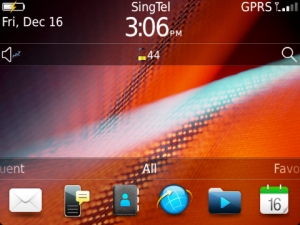 Many people I know would tell me that charging your device, BlackBerry included, is the easiest thing one can do with their device. What would they do? They would plug in the power source and let it sit there. But for some of us, there are still some lingering questions about proper battery care, which is important.
Many people I know would tell me that charging your device, BlackBerry included, is the easiest thing one can do with their device. What would they do? They would plug in the power source and let it sit there. But for some of us, there are still some lingering questions about proper battery care, which is important.
Many of you would come from the time when batteries weren’t as smart or “durable” as some call it, as they are today. There were all sorts of weird and funnt secret tricks and rules some people would use to “extend” their batteries life. Firstly, back then you couldn’t recharge a battery until it had fully discharged (Ni-Mh or Ni-Cd); otherwise, the battery’s capacity and lifespand would have been decreased. Later came the lithium batterieswhich had to be “warmed-up” by fully discharging and recharging it multiple times.
Today’s modern batteries (let alone BlackBerry batteries) are different. There’s none of that to worry about. Charge your BlackBerry whenever you want. In the car? Charge it. Sitting at your desk for 10 minutes? Charge it. In fact, the only real rule to remember is to make sure the battery doesn’t get too low. A study by Cadex found that many Li-ion (lithium ION – our new generation of batteries) batteries fail due to being over-discharged or being too low.
Of course there is definitely no need to keep it at 100% all day, 24/7. But there is no good reason to let your battery level fall into the red, either. Giving your BlackBerry a few minutes of power will do more good than harm, so go ahead!
Now that we know that our battery type is lithium ion, how will this fare against the other batteries?
Lithium-ion vs Lithium batteries
Lithium ion batteries vs traditional Ni-MH/Ni-Cd batteries
What is the DISADVANTAGE?
Lithium-ion batteries are more expensive than similar capacity NiMH or NiCd batteries. This is because they are much more complex to manufacture. Li-ion batteries actually include special circuitry to protect the battery from damage from overcharging or undercharging. They are also more expensive because they are manufactured in much smaller numbers than NiMH or NiCd batteries.
Lithium-ion batteries also require sophisticated chargers that can carefully monitor the charge process. And because of their different shapes and sizes each type of Li-ion battery requires a different, specific charger designed to accommodate its particular size. This means lithium ion battery chargers are more expensive and more difficult to find than NiMH and NiCd battery chargers.
As such, ALWAYS use the ORIGINAL AND GENUINE batteries/chargers as far as possible
Remember, leaving the battery in the red zone will most likely kill it faster than before!
Tips for new batteries:
- When you get a new Blackberry, charge it fully to 100%. There is no 120% or 130%, so once it hits 100%, it is fully charged. This normally takes about 2-4 hours for a new battery, although it is recommended to leave it undisturbed for 8 hours. There is nothing wrong with “over-charging” the battery. Sometimes, new Li-ion batteries will come fully charged out of the box, but in rare cases.
- If you are a brand new BlackBerry user, keep in mind that you are likely using (or playing with) your BlackBerry much more the first few days than in normal routine use. If you think you are having quick battery discharge issues, give yourself a week or so until your daily BlackBerry usage levels off to a perceived normal amount. Don’t freak out after the first one or two days if your battery depletes itself halfway through the day: You probably will be using the device at a higher than normal use.
Tips for routine charging and ongoing use:
- Avoid frequent full discharges because this puts additional strain on the battery. Several partial discharges with frequent recharges are better for lithium-ion than one deep one. Recharging a partially charged lithium-ion does not cause harm because there is no memory.
- Batteries with fuel gauge (such as laptops) should be calibrated by applying a deliberate full discharge once every 30 charges. Running the pack down in the equipment does this. If ignored, the fuel gauge will become increasingly less accurate and in some cases cut off the device prematurely.
- Keep the lithium-ion battery cool. Avoid a hot car. For prolonged storage, try to keep the battery at around 40% charge level.
- Again, don’t drain your battery every day to 10-20% of its charge. You can actually expect battery problems by draining the battery. Again, to repeat, top-off your charge during the day whenever convenient – even ten minutes in the car or at your desk will give you an extra 20-25% charge.
Admins note: contributed by Joseph and built upon by xtramadness
Resources:

